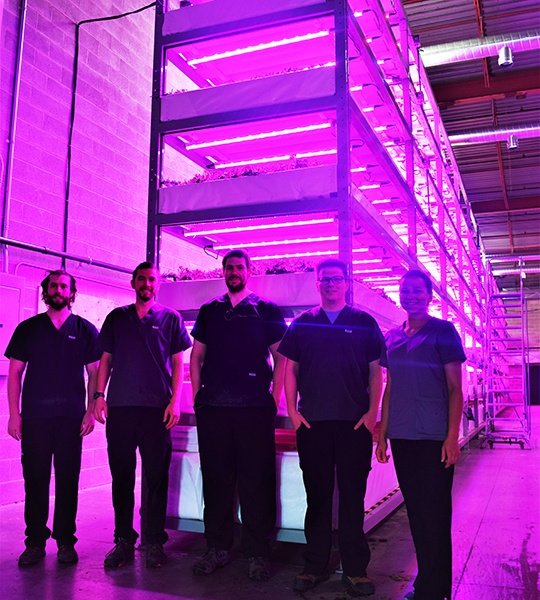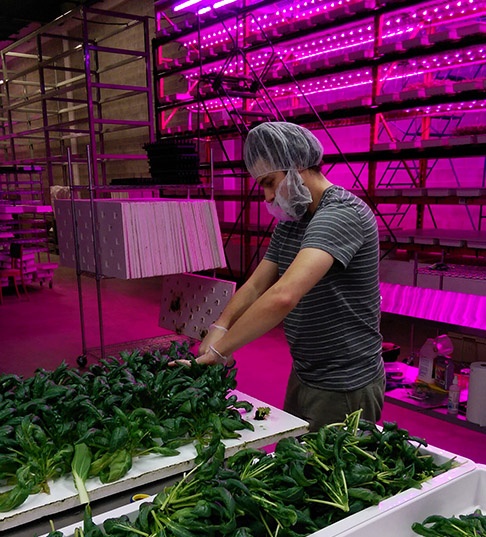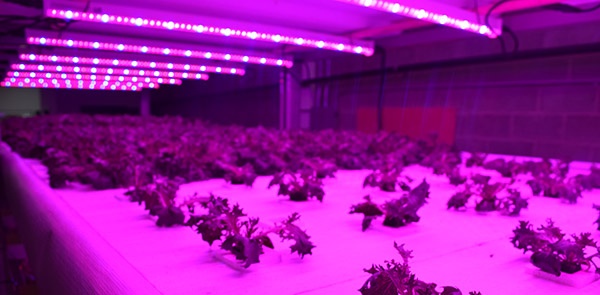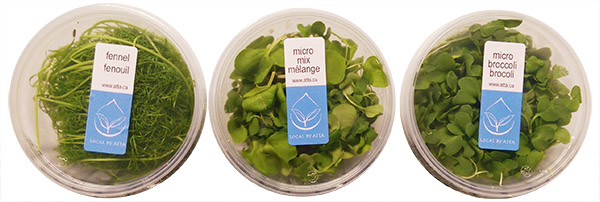Case File Facts
COMPANY: Local by Atta
LOCATION: Moncton, New Brunswick, Canada
CROPS: Local by Atta produces a variety of lettuces, basil, kale, Swiss chard, bok choy, cilantro and microgreens. Products are sold at farmers markets, health food stores, grocery stores, restaurants and through a weekly basket program. The basket program is expected to increase sales as the company looks to expand with pick up at local businesses, municipal buildings and its new production facility.
TECHNOLOGY: GE Arize Lynk LED Growing System

Background
Local by Atta was founded by Julian and Jesse Howatt. The two brothers, who grew up on a farm, have professional backgrounds in urban planning.
“Even though we grew up on a farm we have an interest in cities,” said Julian Howatt. “In 2012-2013 we reached a point in our careers that we wanted to start an urban farm together. I had been growing lettuce hydroponically in my apartment. We scaled it up to a shed in my brother’s backyard. In late 2013 we started a small-scale commercial farm and in March 2014 we began selling at a local farmers market.”
Julian said one of the reasons that they chose to do indoor hydroponics was the limitations of an outdoor urban farm.
“With an outdoor urban farm there are limitations with the land that is available and it is more difficult to do very intensive farming,” he said. “Also, our climate is not conducive to long growing seasons because of the short summers.
“An indoor farm provides a major competitive advantage for leafy greens. Except for the summer when there is a local supply, for most of the year the majority of leafy greens are coming from California and other parts of the West Coast. We saw the biggest potential starting to sell our products from September through June. It made more sense given the constraints of trying to produce high yields on a small land-based urban farm to go year-round with an indoor farm using a hydroponic production system.”
When the Howatts started growing hydroponically in their backyard shed they were looking to trial a couple of LED lights.
“We wanted a horticultural quality LED fixture and not just some random LED from a hydroponic store where we weren’t sure about the quality of the lights,” Julian said. “I googled horticultural LEDs and found Hort Americas online. I contacted Chris Higgins and I explained that we were setting up a small hydroponic production facility growing lettuce. I spoke to Chris for about an hour and talked about LEDs and lighting issues and ended up purchasing a couple of LEDs. I also read the Hort Americas case study article on Jeffrey Orkin at Greener Roots Farm in Nashville, Tenn. We eventually contacted Jeffrey because we were looking for other hydroponic farmers to exchange notes with and get some advice.”

Challenge
In late 2013 the Howatts began growing in a commercial building renting 1,500 square feet of space.
“We started off with a nutrient film technique system with PVC channels,” Julian said. “We figured out very quickly that the plumbing for this type of system is much more complex resulting in more issues including leaks, flooding and clogging. We eventually switched over to a raft system.
“Our raft system was five levels high. It was 12 feet high about 24 feet long and 4 feet wide. We had two of these systems. These were our major production systems.”
When the Howatts moved into the building they had limited funds to set up the production facility.
“At the very beginning we started with more fluorescent than LED lights,” Julian said. “We didn’t have a lot of money and LEDs were more expensive. We weren’t willing to make the jump to just LEDs at that point.”
A fire in January 2016 destroyed the interior of the building including $10,000 worth of crops that had just been planted.

Solution
“We lost the entire farm to the fire and had to restart,” Julian said. “We had maxed out the space in the building and had already started considering options of expanding, relocating and scaling up our production before the fire occurred. We restarted the business in June 2016 and started selling greens again in September 2016.”
The company’s new location consists of 7,000 square feet with 1,000 square feet of that space used for office, storage and cold storage.
“Our set up is basically a big rectangular space,” Julian said. “We have the space for six large towers. We have the frames built and are currently using three of them. Each tower measures 16 feet tall, 50 feet long and 4½ feet wide and has six production levels. Each level has two ponds measuring 4- by 24-feet. As we expand we are filling in the frames with the ponds, rafts, plumbing, lighting and wiring. The water reservoir is at the bottom of the tower and the water is pumped up to each level and then drains down to the bottom.
“Of the nearly 6,000 square feet of production area we currently are only using half of that space. By next summer we expect to be using all of it. We have about 4,000 square feet under lights. That will double as we expand. It will be close to 8,000 square feet under lights once we are at full production.”
For the new facility the Howatts chose GE LEDs which they have been using since January 2017.
“After the fire we began looking at rebuilding and we only considered installing LEDs,” said Julian. “We didn’t even consider fluorescents. It was mostly because of power constraints. The fluorescent lamps were consuming too much power and generating too much heat. It wasn’t feasible to add more fluorescents.
“Because of the exchange rates we shopped around for price quotes and even though Hort Americas wasn’t the lowest, what we really liked was the customer service that the company offered and the industry knowledge that Chris had that most of the other lighting suppliers didn’t. The other suppliers we contacted had experience related to greenhouse production, but they weren’t as knowledgeable in regards to indoor farming.”

Benefits
Julian said one of the advantages of using the GE LEDs is their energy efficiency.
“The biggest constraint for us besides money is the power constraint,” he said. “How much power do we have access to in the building can be an issue. It’s not as simple as just getting more power from the utility company.
“The GE LEDs are more efficient so we can get more light for the same amount of power, which is a nice bonus for us. Most of our crops grow better under the GE lights when they have the same light intensity or when we can give them more light because we can afford the power. Generally for most crops the yields are better and the quality of the product is better. This is especially true for red lettuces. We get better red pigmentation.”
For more: Local by Atta, (506) 233-0393; moncton@atta.ca; http://www.atta.ca; https://www.facebook.com/LocalByAtta.
Click here for additional Case Studies and Horti-Facts.
Prepared by Hort Americas 2017© Photos courtesy of Local by Atta






